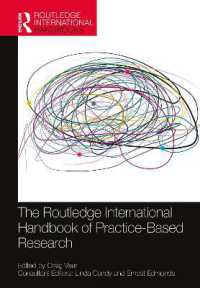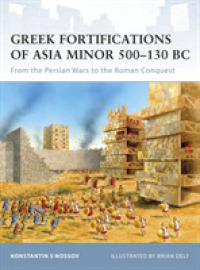- ホーム
- > 洋書
- > 英文書
- > Science / Mathematics
Full Description
A comprehensive discussion of automated transit
This book analyzes the successful implementations of automated transit in various international locations, such as Paris, Toronto, London, and Kuala Lumpur, and investigates the apparent lack of automated transit applications in the urban environment in the United States.
The book begins with a brief definition of automated transit and its historical development. After a thorough description of the technical specifications, the author highlights a few applications from each sub-group of the automated transit spectrum. International case studies display various technologies and their applications, and identify vital factors that affect each system and performance evaluations of existing applications. The book then discusses the planning and operation of automated transit applications at both macro and micro levels. Finally, the book covers a number of less successful concepts, as well as the lessons learned, allowing readers to gain a comprehensive understanding of the topic.
Key features:
Provides a thorough examination of automated transit applications, their impact and implications for society
Written by the committee chair for the Automated Transit Systems Transportation, Research Board
Offers essential information on planning, costs, and applications of automated transit systems
Covers driverless metros, automated LRT, group and personal rapid transit, a review of worldwide applications
Includes capacity and safety guidelines, as well as vehicles, propulsion, and communication and control systems
This book is essential reading for engineers, researchers, scientists, college or graduate students who work in transportation planning, engineering, operation and management fields.
Contents
FOREWORD xi
PREFACE xiii
ACKNOWLEDGMENTS xv
ABBREVIATIONS xvii
1 INTRODUCTION 1
1.1 Automated Transportation / 2
1.2 Automated Transit / 4
1.3 Individual Modes of Automated Transit Family / 8
1.3.1 Automated Guideway Transit / 8
1.3.2 Automated Bus / 14
1.3.3 Automated Personal Transit / 15
2 HISTORICAL DEVELOPMENT 23
2.1 Conceptual Initiations: 1960s and Prior / 23
2.2 Pilot Demonstrations: 1970s-1980s / 27
2.3 Applications in Confined Environments: 1990s-2000s / 32
2.4 Multipolar Development: New Millennium and Beyond / 36
2.4.1 Exponential Growth of Driverless Metros / 36
2.4.2 Steady Expansion of APM Systems / 39
2.4.3 Emergence of PRT Applications / 39
3 TECHNOLOGY SPECIFICATIONS 47
3.1 Vehicles / 48
3.2 Guideway / 51
3.3 Propulsion and System Power / 52
3.4 Communications and Control / 53
3.5 Stations and Platforms / 55
3.6 Maintenance and Storage Facilities / 58
4 APPLICATIONS 63
4.1 Driverless Metro in Paris / 64
4.1.1 Clean Slate of Automation: Line No. 14 / 64
4.1.2 Conversion from Manual to DLM: Paris Metro Line No. 1 / 67
4.2 Automated LRT in Singapore / 70
4.3 Detroit Downtown People Mover / 72
4.4 Automated People Movers in Las Vegas / 74
4.5 Dallas-Fort Worth Airport APM / 79
4.6 AirTrain at JFK Airport / 80
4.7 Morgantown Group Rapid Transit / 81
4.8 Ultra PRT at Heathrow International Airport / 84
5 CHARACTERISTICS OF AUTOMATED TRANSIT APPLICATIONS 89
5.1 System Characteristics / 89
5.1.1 Physical Layouts / 90
5.1.2 Scale of Systems / 94
5.2 Operating Characteristics / 96
5.2.1 Operating Strategies / 97
5.2.2 Station Operations / 99
5.2.3 System Capacity / 101
5.3 Financial Characteristics / 103
5.3.1 Capital Investment / 104
5.3.2 Operating Expenses / 107
5.3.3 Life Cycle Cost / 110
6 ASSESSMENT OF AUTOMATED TRANSIT PERFORMANCES 115
6.1 System Performance / 115
6.2 Reliability / 119
6.3 Safety and Security / 126
6.3.1 Safety Records for Automated Guideway Transit / 126
6.3.2 Comparison with Other Guideway Transit / 129
6.4 Cost-Effective Analysis / 133
7 PLANNING CONSIDERATIONS 139
7.1 Public Policy / 142
7.1.1 Research / 142
7.1.2 Design Standards / 143
7.1.3 National Policy / 144
7.2 Long-Range Transportation Planning / 145
7.2.1 Trip Generation / 147
7.2.2 Trip Distribution or Destination Choice Module / 148
7.2.3 Mode and Occupancy Choice Module / 149
7.2.4 Trip Assignment Module / 150
7.3 Operations Planning / 151
8 BUSINESS MODELS FOR AUTOMATED TRANSIT APPLICATIONS 157
8.1 Public Owner and Operator / 159
8.2 Private Owner and Operator / 162
8.3 Public and Private Partners / 166
9 LESSONS LEARNED 173
9.1 Driving Can Be Replaced / 174
9.2 Public Policy: A Double-Edged Sword / 175
9.3 Design Matters / 177
9.4 Demonstration Projects are Needed / 178
10 FUTURE DIRECTIONS 181
10.1 Grow Automated Transit Applications / 182
10.2 Create New Mode / 183
10.3 Conduct Further Research / 185
10.4 Sponsor Demonstration Projects / 187
10.5 Develop Performance Measures / 188
10.6 Encourage Diverse Business Models / 189
10.7 Gather Public Support / 191
INDEX 197







